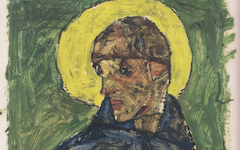Schiele’s Portrait of a Lady in an Orange Hat (1910)

Egon Schiele, Portrait of a Woman in a Orange Hat (1910) Gouache, crayon, and pencil on paper. Private Collection.
Click image to enlarge.
Ever since Dante made Beatrice his vision of Wisdom in the Divine Comedy, male painters have often suggested that beautiful women are the ultimate creative essence in their minds, beautiful, truthful and fertile. Take a look at how I explain Holbein's Portrait of Anne of Cleves (c.1539), Degas' Seated Woman (1877), Lord Leighton's Flaming June (1895) and, only 9 years before Egon Schiele's portrait at left, Matisse's La Coiffure (1901).1 In each of them, the principal figure emerges from an amorphous image of the artist's head below.
Click next thumbnail to continue
Note here the unusually expressive contour of the woman's sleeve below her hand, lines bouncing around with little modeling. They are such an important part of the overall effect, though, that Schiele seems to be warning us to take notice. Here's why....
Click next thumbnail to continue

L: Detail of Schiele's Portrait of a Woman in a Orange Hat (1910)
R: Schiele, Self-portrait aged 16, detail (1906) Charcoal on paper. Albertina, Vienna.
Click image to enlarge.
Just as in those earlier examples, Schiele's woman is sitting in Schiele's mind. No-one has noted before that her sleeve intentionally suggests his own facial profile as seen in an early self-portrait. The sleeve is then an imaginative rendering of himself as part and parcel of the woman's portrait. I tend to think that these hidden and abstract "faces" represent mental images of what the artists imagined they might look like in their mind.2 Here, Schiele's profile and "eyes" are not randomly placed either. They are directly below her hand as though symbolically it is the artist's own "hand" sprouting from his head.
Click next thumbnail to continue
Through this hand (his craft) Schiele has constructed a "realistic" (ie., drawn) portrait of the feminine source of Wisdom in his mind whose orange hat is a modern substitute for the gold of a medieval halo. On the surface, this is a portrait of an unknown woman. It is also the portrait of a "goddess" emerging from his mind in which her hand, touching her torso, "paints" herself.3 Yet it is also his hand and, thus being androgynous, it can be seen to represent the universal hand of human creativity.
The troubadour poets in the 11th century were the first to exalt a woman allegorically as a symbol of divine perfection in their mind; Dante, two centuries later, did the same thereby making the theme a standard part of poetic practice in literature and visual art for centuries to come. It is by no means worn out.
More Works by Schiele
In the epistle of an apostle, the letters matter; as they also do in the self-portrait of a prophet, even if self-proclaimed.

Schiele’s Self-portrait as a Saint (1913)
Notes:
1. Paul Klee among others continued the same technique in Tightrope Walker (1923), a rare occasion on which the hidden head has already been recognized by others. See also how Rubens did it in Miracles of St. Ignatius of Loyola (c.1619). For Klee, Constance Naubert-Riser in The Great Parade: Portrait of the Artist as Clown, ed. Jean Clair (Yale University Press) 2004, p. 150.
2. For a description of what mental images probably look like, see Simon Abrahams, "Cubism Explained" (2011)
3. To see how touch in art symbolizes the act of painting, consider examples under the theme Pointing and Touch.
Original Publication Date on EPPH: 25 Jun 2015. © Simon Abrahams. Articles on this site are the copyright of Simon Abrahams. To use copyrighted material in print or other media for purposes beyond 'fair use', you must obtain permission from the copyright owner. Websites may link to this page without permission (please do) but may not reproduce the material on their own site without crediting Simon Abrahams and EPPH.



